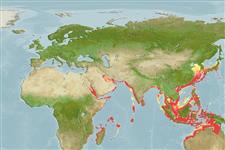Common names from other countries
Environment: milieu / climate zone / depth range / distribution range
экология
; пределы глубины 30 - 120 m (Ref. 275). Tropical; 41°N - 24°S, 32°E - 143°E (Ref. 275)
Indo-West Pacific: from Mozambique to Red Sea and Japan.
Length at first maturity / Size / Вес / Возраст
Maturity: Lm ? range ? - ? cm Max length : 10.0 cm ML самец/пол неопределен; (Ref. 275); наибольший вес (опубликованные данные): 400.00 g (Ref. 275)
A small to moderate-sized species recognized by a distinctive color pattern consisting of large, light-colored round patches, separated by dark reticulations over the entire dorsal surface. There is also a light cream-colored longitudinal stripe along the dorsal midline of the mantle.
Maximum total length is 30 cm. Supports subsistence fisheries in East Africa (Ref. 3722). Found in sand and muddy sand areas. Inhabits holes and defends its turf. Solitary with crepuscular behavior (Ref. 101169). Benthic. Inhabits the continental shelf (Ref. 9773).
Life cycle and mating behavior
половая зрелость | размножение | нерест | икра | Fecundity | личинки
Members of the class Cephalopoda are gonochoric. Male and female adults usually die shortly after spawning and brooding, respectively. Mating behavior: Males perform various displays to attract potential females for copulation. During copulation, male grasp the female and inserts the hectocotylus into the female's mantle cavity where fertilization usually occurs. Life cycle: Embryos hatch into planktonic stage and live for some time before they grow larger and take up a benthic existence as adults.
Основная ссылка
ссылки | координатор | соавторы
Roper, C.F.E., M.J. Sweeney and C.E. Nauen. 1984. (Ref. 275)
Статус Красного Списка МСОП (Ref. 130435)
Статус СИТЕС (Ref. 108899)
Not Evaluated
Not Evaluated
Использование человеком
рыболовство: коммерческий
| FishSource |
инструменты
дополнительная информация
ресурсы в Интернет
Estimates based on models
Preferred temperature
(Ref.
115969): 18.2 - 28.3, mean 27 (based on 733 cells).
Уязвимость
Low vulnerability (10 of 100).
